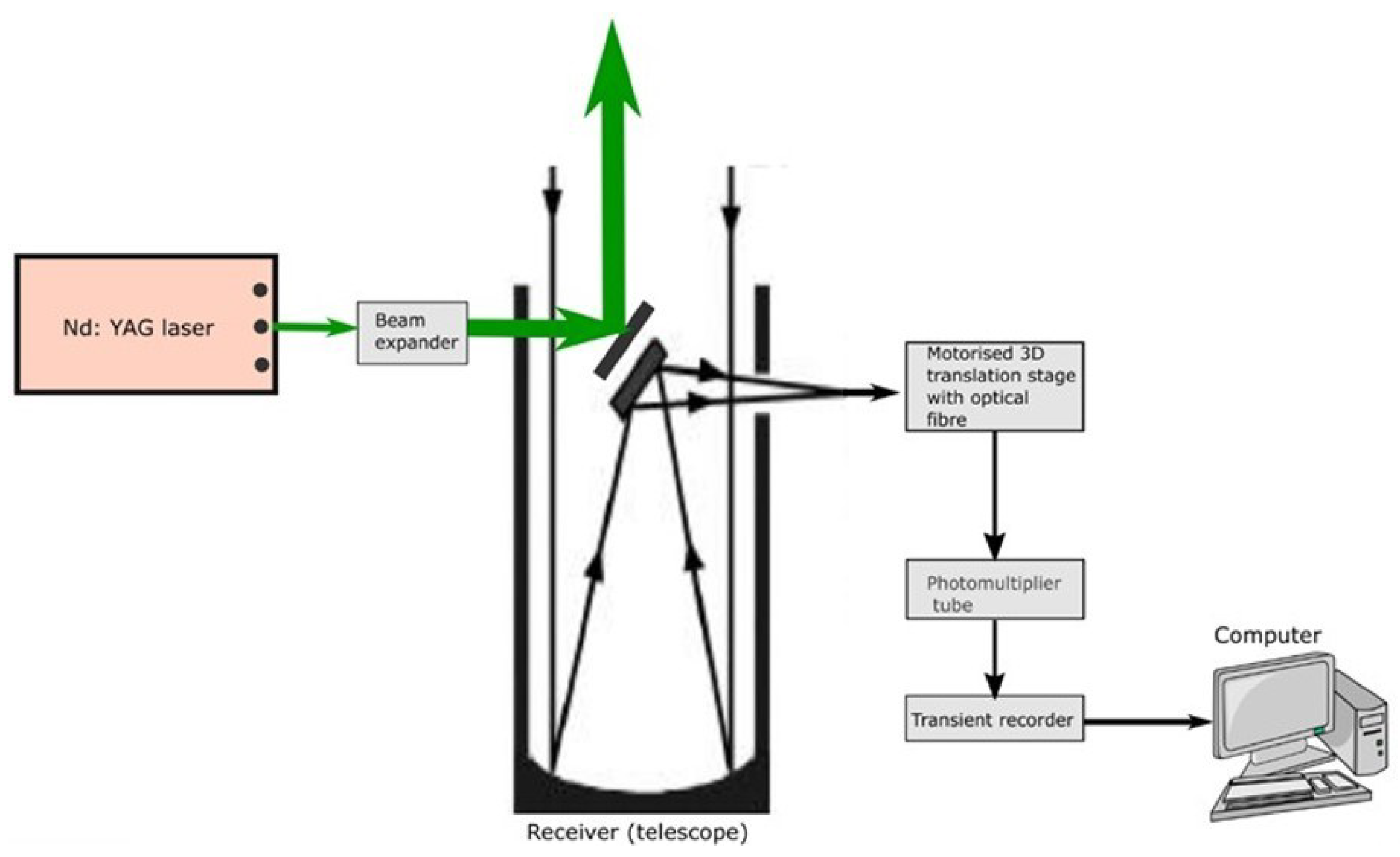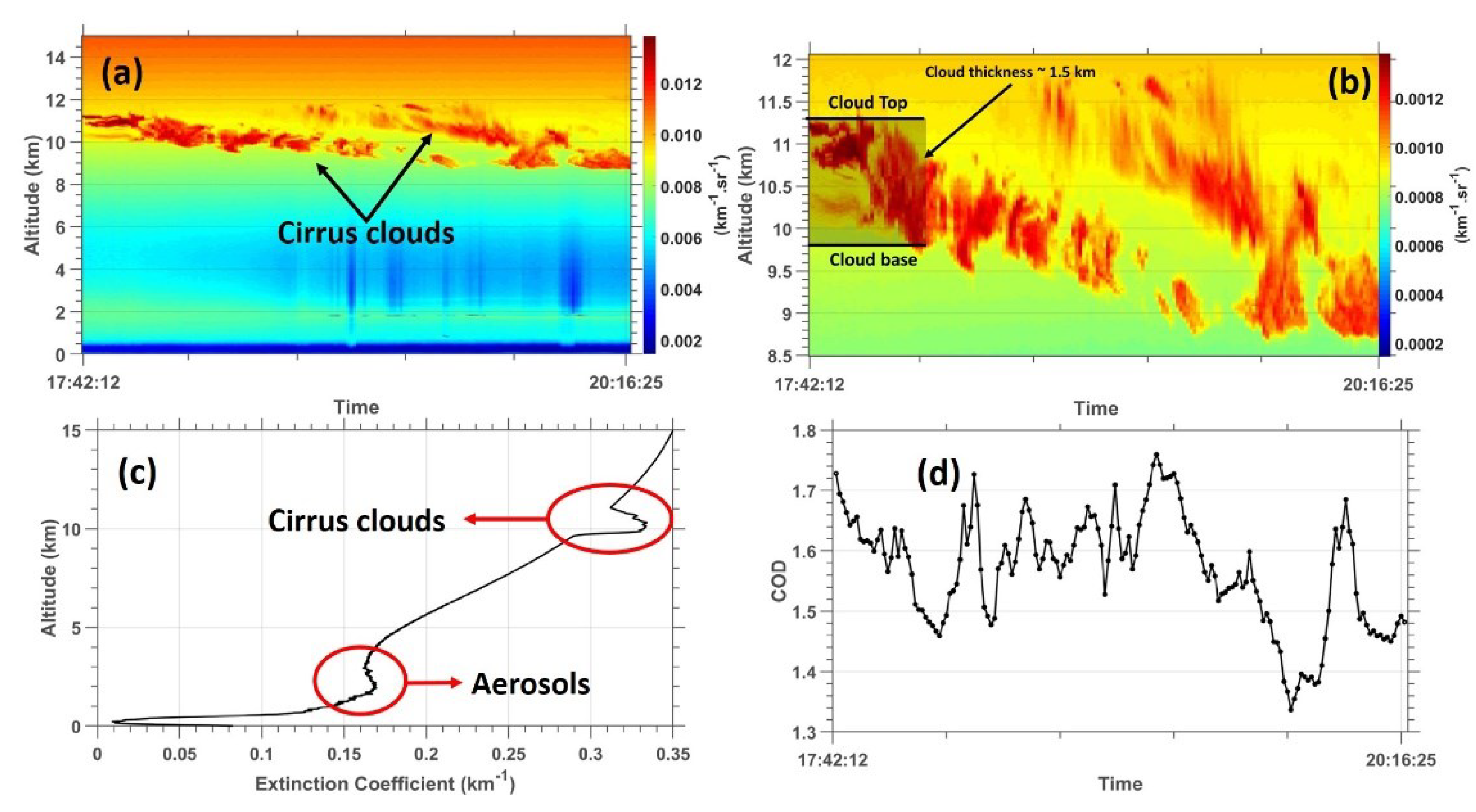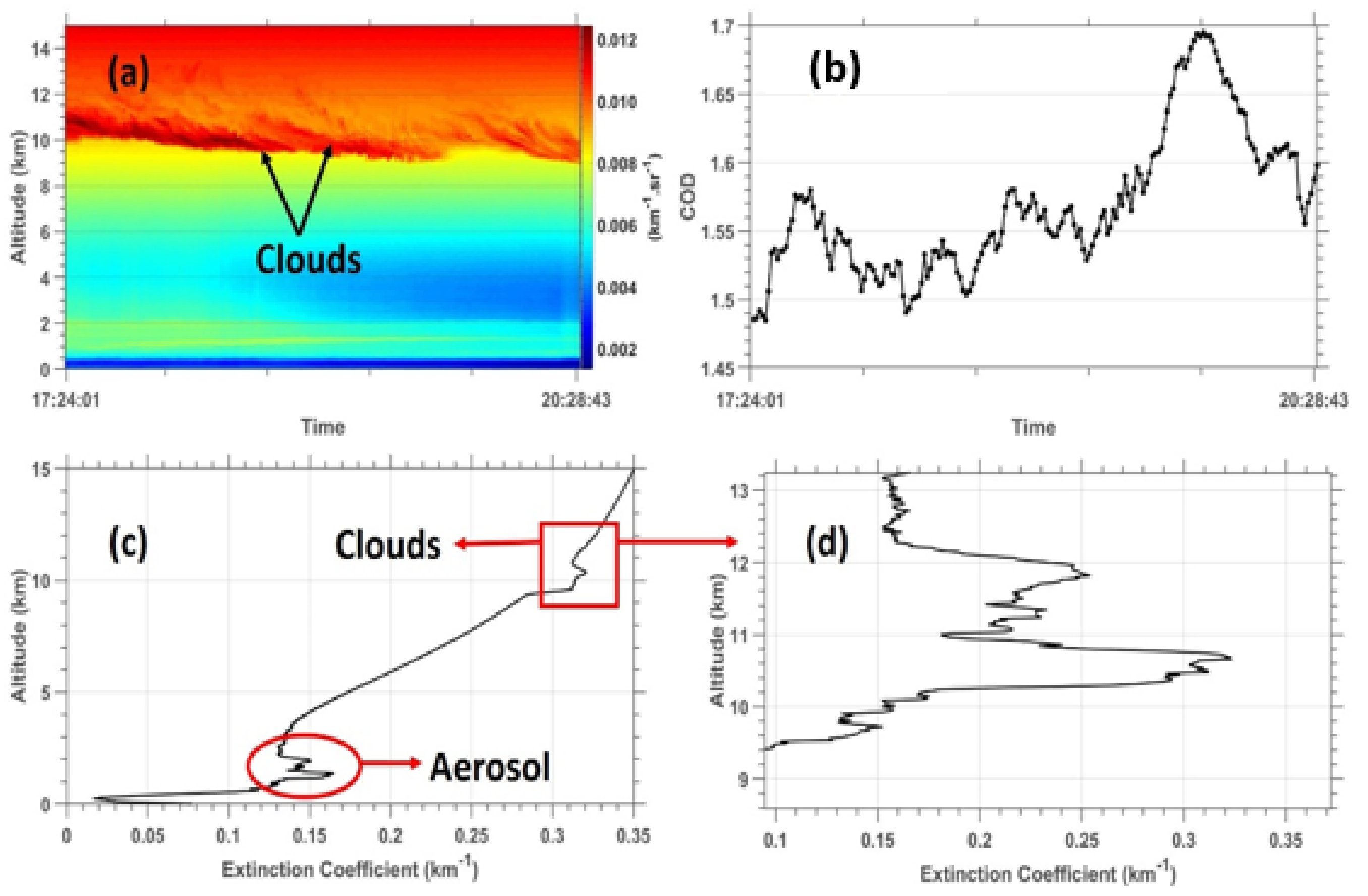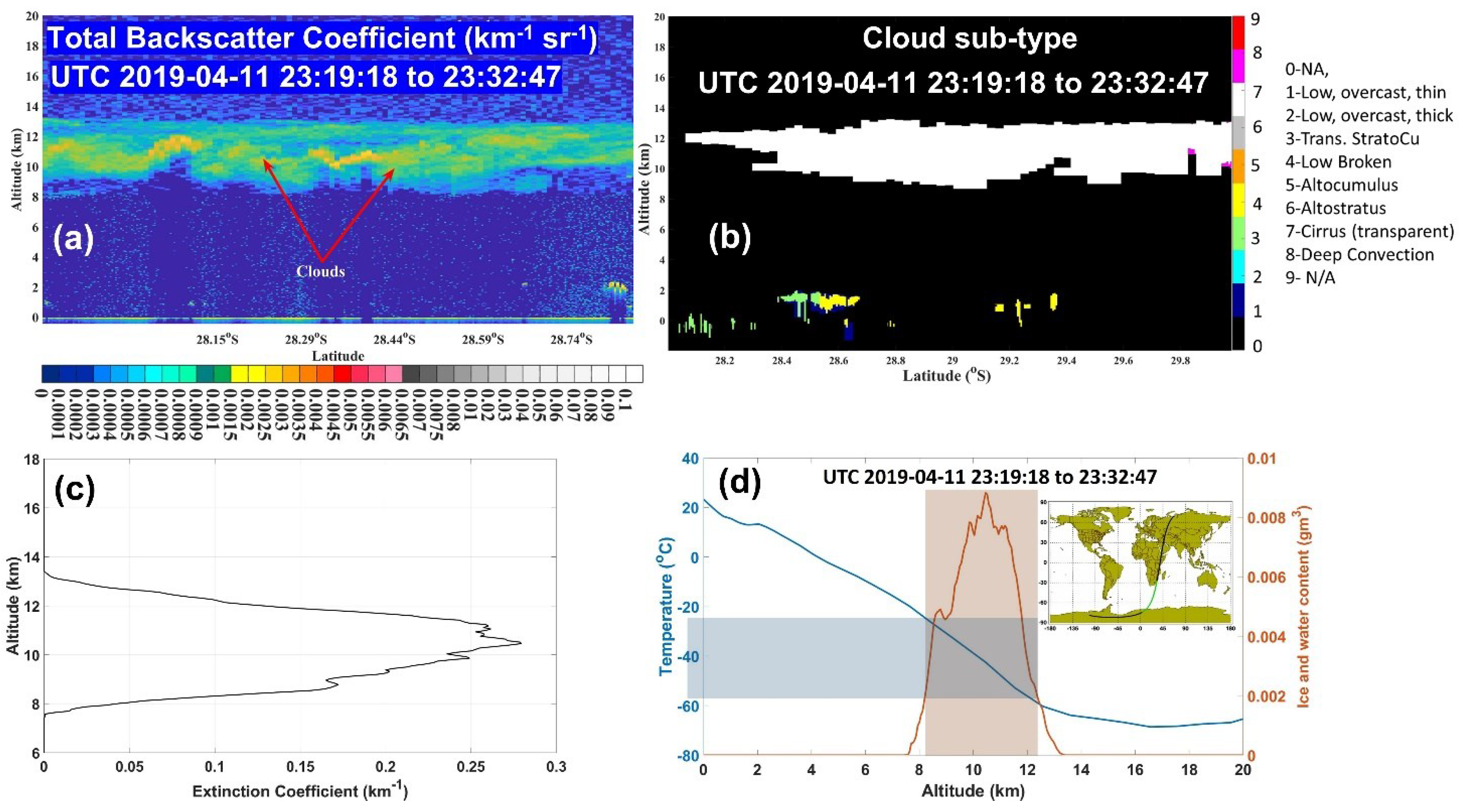First Observations of Cirrus Clouds Using the UZ Mie Lidar over uMhlathuze City, South Africa
Abstract
:1. Introduction
2. Study Site
3. Methods and Data
3.1. UZ Lidar
3.2. CALIPSO
4. Results and Discussion
5. Conclusions
Author Contributions
Funding
Institutional Review Board Statement
Informed Consent Statement
Data Availability Statement
Acknowledgments
Conflicts of Interest
References
- Liou, K.N. Influence of cirrus clouds on weather and climate processes: A global perspective. Mon. Weather Rev. 1986, 114, 1167–1199. [Google Scholar] [CrossRef]
- Sivakumar, V.; Bhavanikumar, Y.; Rao, P.B.; Mizutani, K.; Aoki, T.; Yasui, M.; Itabe, T. Lidar observed characteristics of the tropical cirrus clouds. Radio sci. 2003, 38, 1094. [Google Scholar] [CrossRef]
- Nicolas, J.P.; Bromwich, D.H. Climate of West Antarctica and influence of marine air intrusions. J. Clim. 2011, 24, 49–67. [Google Scholar] [CrossRef] [Green Version]
- Qian, Y.; Long, C.N.; Wang, H.; Comstock, J.M.; McFarlane, S.A.; Xie, S. Evaluation of cloud fraction and its radiative effect simulated by IPCC AR4 global models against ARM surface observations. Atmos. Chem. Phys. 2012, 12, 1785–1810. [Google Scholar] [CrossRef] [Green Version]
- Zhou, C.; Zelinka, M.D.; Klein, S.A. Analyzing the dependence of global cloud feedback on the spatial pattern of sea surface temperature change with a Green’s function approach. J. Adv. Model Earth Syst. 2017, 9, 2174–2189. [Google Scholar] [CrossRef] [Green Version]
- Stubenrauch, C.J.; Rossow, W.B.; Kinne, S.; Ackerman, S.; Cesana, G.; Chepfer, H.; Di Girolamo, L.; Getzewich, B.; Guignard, A.; Heidinger, A.; et al. Assessment of Global Cloud Datasets from Satellites: Project and Database Initiated by the GEWEX Radiation Panel. Bull. Am. Meteorol. Soc. 2013, 94, 1031–1049. [Google Scholar] [CrossRef]
- Karlsson, K.-G.; Dybbroe, A. Evaluation of arctic cloud products from the EUMETSAT climate monitoring satellite application facility based on CALIPSO-CALIOP observations. Atmos. Chem. Phys. 2010, 10, 1789–1807. [Google Scholar] [CrossRef] [Green Version]
- Ansmann, A.; Riebesell, M.; Wandinger, U.; Weitkamp, C.; Voss, E.; Lahmann, W.; Michaelis, W. Combined Raman elastic-backscatter LIDAR for vertical profiling of moisture, aerosol extinction, backscatter, and LIDAR ratio. Appl. Phys. 1992, B55, 18–28. [Google Scholar] [CrossRef]
- Sassen, K.; Griffin, M.; Dood, G.C. Optical scattering and microphysical properties of subvisible cirrus clouds, and climatic implications. J. Appl. Meteorol. 1989, 28, 91–98. [Google Scholar] [CrossRef] [Green Version]
- Shikwambana, L.; Sivakumar, V. Observation of Clouds Using the CSIR Transportable LIDAR: A Case Study over Durban, South Africa. Adv. Meteorol. 2016, 2016, 4184512. [Google Scholar] [CrossRef]
- Wang, Z.; Shishko, V.A.; Konoshonkin, A.V.; Kustova, N.V.; Borovoi, A.G.; Matvienko, G.G.; Xie, C.; Liu, D.; Wang, Y. The study of cirrus clouds with the polarization lidar in the South-East China (Hefei). Atmos. Ocean. Opt. 2017, 30, 234–235. [Google Scholar] [CrossRef]
- Okello, N.O.; Okello, T.W.; Zuncke, M. Public perceptions of air quality status and suggestions for improvement: The case of Richards Bay and its surroundings, Mhlathuze Local Municipality, South Africa. Clean Air J. 2020, 30, 1–10. [Google Scholar] [CrossRef]
- Comerón, A.; Muñoz-Porcar, C.; Rocadenbosch, F.; Rodríguez-Gómez, A.; Sicard, M. Current Research in Lidar Technology Used for the Remote Sensing of Atmospheric Aerosols. Sensors 2017, 17, 1450. [Google Scholar] [CrossRef] [PubMed] [Green Version]
- Winker, D.M.; Pelon, J.; Coakley, J.A.; Ackerman, S.A.; Charlson, R.J.; Colarco, P.R.; Flamant, P.; Fu, Q.; Hoff, R.M.; Kittaka, C.; et al. The CALIPSO mission: A global 3D view of aerosols and clouds. Bull. Am. Meteorol. Soc. 2010, 91, 1211–1229. [Google Scholar] [CrossRef]
- Nellore, M.K.; Kannan, V. Lidar Observed Optical Properties of Tropical Cirrus Clouds Over Gadanki Region. Front. Earth Sci. 2020, 8, 140. [Google Scholar] [CrossRef]
- Kottek, M.; Grieser, J.; Beck, C.; Rudolf, B.; Rubel, F. World map of the Köppen-Geiger climate classification updated. Meteorol. Zeitschrift 2006, 15, 259–263. [Google Scholar] [CrossRef]
- Sharma, A.; Sivakumar, V.; Bollig, C.; van der Westhuizen, C.; Moema, D. System description of the mobile LIDAR of the CSIR, South Africa. South Afr. J. Sci. 2009, 105, 456–462. [Google Scholar] [CrossRef]
- Klett, J.D. Stable analytical inversion solution for processing lidar returns. Appl. Opt. 1981, 20, 211–220. [Google Scholar] [CrossRef] [Green Version]
- Fernald, F.G. Analysis of atmospheric lidar observations: Some comments. Appl. Opt. 1984, 23, 652–653. [Google Scholar] [CrossRef]
- Stephens, G.L.; Vane, D.G.; Boain, R.J.; Mace, G.G.; Sassen, K.; Wang, Z.; Illingworth, A.J.; O’Connor, E.J.; Rossow, W.B.; Durden, S.L.; et al. The CloudSat mission and the A-Train: A new dimension of space-based observations of clouds and precipitation. Bull. Am. Meteorol. Soc. 2002, 83, 1771–1790. [Google Scholar] [CrossRef] [Green Version]
- Hunt, W.H.; Winker, D.M.; Vaughan, M.A.; Powell, K.A.; Lucker, P.L.; Weimer, C. CALIPSO Lidar Description and Performance Assessment. J. Atmos. Ocean Technol. 2009, 26, 1214–1228. [Google Scholar] [CrossRef]
- Winker, D.M.; Pelon, J.; McCormick, M.P. The CALIPSO mission: Spaceborne lidar for observation of aerosols and clouds. In Proceedings of the Volume 4893, Lidar Remote Sensing for Industry and Environment Monitoring III, Hangzhou, China, 8 May 2003. [Google Scholar] [CrossRef] [Green Version]
- Winker, D.M.; Tackett, J.L.; Getzewich, B.J.; Liu, Z.; Vaughan, M.A.; Rogers, R.R. The global 3-D distribution of tropospheric aerosols as characterized by CALIOP. Atmos. Chem. Phys. 2013, 13, 3345–3361. [Google Scholar] [CrossRef] [Green Version]
- Winker, D.M.; Vaughan, M.A.; Omar, A.; Hu, Y.; Powell, K. Overview of the CALIPSO Mission and CALIOP Data Processing Algorithms. J. Atmos. Ocean Technol. 2009, 26, 2310–2323. [Google Scholar] [CrossRef]
- Sassen, K.; Cho, B.S. Subvisual-Thin Cirrus Lidar Dataset for Satellite Verification and Climatological Research. J. Appl. Meteorol. Climatol. 1992, 31, 1275–1285. [Google Scholar] [CrossRef] [Green Version]
- Immler, F.; Schrems, O. LIDAR measurements of cirrus clouds in the northern and southern midlatitudes during INCA (55°N, 53°S): A comparative study. Geophys. Res. Lett. 2002, 29, 6389. [Google Scholar] [CrossRef] [Green Version]





| Parameter | |
|---|---|
| Wavelength | 532 nm: Nd: YAG |
| Maximum pulse energy | 160 mJ |
| Telescope | 404 cm |
| Detector | PMT |
| Field of View | 500 μrad |
| Vertical and temporal resolutions | 10 m and 10 s |
| CALIOP Parameters | |
|---|---|
| Laser | Nd: YAG, diode-pumped, Q-switched, frequency doubled |
| Wavelengths | 532 nm, 1064 nm |
| Pulse energy | 110 mJ |
| Repetition rate | 20.25 Hz |
| Receiver telescope | 1.0 m diameter |
| Polarization | 532 nm |
| Footprint/FOV | 100 m/130 µrad |
| Vertical resolution | 30–60 m |
| Horizontal resolution | 333 m |
Publisher’s Note: MDPI stays neutral with regard to jurisdictional claims in published maps and institutional affiliations. |
© 2022 by the authors. Licensee MDPI, Basel, Switzerland. This article is an open access article distributed under the terms and conditions of the Creative Commons Attribution (CC BY) license (https://creativecommons.org/licenses/by/4.0/).
Share and Cite
Mbatha, N.; Shikwambana, L. First Observations of Cirrus Clouds Using the UZ Mie Lidar over uMhlathuze City, South Africa. Appl. Sci. 2022, 12, 4631. https://doi.org/10.3390/app12094631
Mbatha N, Shikwambana L. First Observations of Cirrus Clouds Using the UZ Mie Lidar over uMhlathuze City, South Africa. Applied Sciences. 2022; 12(9):4631. https://doi.org/10.3390/app12094631
Chicago/Turabian StyleMbatha, Nkanyiso, and Lerato Shikwambana. 2022. "First Observations of Cirrus Clouds Using the UZ Mie Lidar over uMhlathuze City, South Africa" Applied Sciences 12, no. 9: 4631. https://doi.org/10.3390/app12094631
APA StyleMbatha, N., & Shikwambana, L. (2022). First Observations of Cirrus Clouds Using the UZ Mie Lidar over uMhlathuze City, South Africa. Applied Sciences, 12(9), 4631. https://doi.org/10.3390/app12094631






